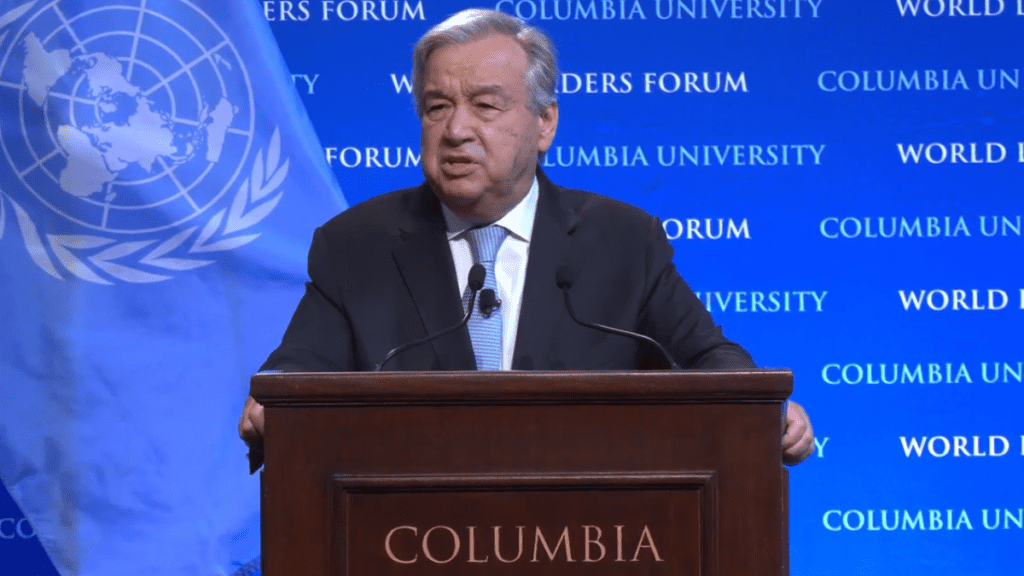United Nations Secretary-General Antonio Guterres painted a bleak picture when presenting a report on this year’s state of the planet, claiming that a green recovery from the pandemic could the last chance for a reset to save Earth.

Guterres gave a speech at Columbia University in New York to introduce the provisional 2020 State of the Global Climate report by the World Meteorological Organization (WMO). This year is on course to be one of the three warmest ever recorded, according to the report, and as emissions continue to rise, temperatures are also expected to do the same.
“To put it simply, the state of the planet is broken,” Guterres said. “Humanity is waging war on nature. This is suicidal. Nature always strikes back — and it is already doing so with growing force and fury. Biodiversity is collapsing. One million species are at risk of extinction. Ecosystems are disappearing before our eyes.”
The UN head said climate and environmental policies have failed to rise to the challenge, as emissions this year are 60% higher than in 1990. The current emissions put the world on a trend of a temperature rise between 3ºC and 5ºC by 2100, Guterres said. Still, there’s still hope, as countries can build a “truly global” coalition for carbon neutrality — but we need to act now.
The Paris Agreement on climate change, set up in 2015, asks countries to present climate pledges (nationally determined contributions, or NDCs) to avoid the temperature going over 2ºC by the end of the century. While that goal seems impossible now, countries are expected to present new pledges over the next few months to address the gap.
“Making peace with nature is the defining task of the 21st century. It must be the top, top priority for everyone, everywhere,” Guterres said. “In this context, the recovery from the pandemic is an opportunity. We can see rays of hope in the form of a vaccine. But there is no vaccine for the planet. Nature needs a bailout.”
Countries have already spent trillions of dollars as part of the recovery from the pandemic, amid calls by scientists and campaigners to use those funds for a green recovery. Guterres said it’s time to “flick the green switch” as a sustainable economy would create jobs, cleaner infrastructure, and a resilient future. In other words, we can build a greener future while also fostering a thriving economy, while the opposite might not be an option.
While we are dealing with a true planetary emergency, the UN head said he’s hopeful. Many cities are becoming greener, the circular economy is reducing waste and environmental laws have growing reach. A new world is taking shape, he said, as people are understanding the need to reduce their carbon footprint.
“This is a moment of truth for people and planet alike. COVID and climate have brought us to a threshold. We cannot go back to the old normal of inequality, injustice and heedless dominion over the Earth,” he said. “Instead we must step towards a safer, more sustainable and equitable path.”
The worrying state of the planet
The average global temperature is set to reach about 1.2ºC above pre-industrial levels and there’s at least a one in five chance of it exceeding 1.5ºC by 2024 — an important benchmark, and an unfortunate one to pass.
The Intergovernmental Panel on Climate Change (IPCC), a group of leading climate experts from around the world, warned that 1.5ºC is the danger line for global warming. Exceeding that threshold would trigger severe climate effects around the world that might be irreversible, such as the loss of 99% of the coral reefs.
The WHO said this year has been unusually hot despite the cooling effect of La Niña, the climate phenomenon associated with below-normal sea surface temperatures in the Pacific Ocean with global implications. Its impact has been more than offset by heat trapped in the atmosphere by greenhouse gasses. In the past, unusually warm years matched with a strong El Niño event, which is the opposite of La Niña and causes higher sea surface temperatures and warmer global temperatures. This is no longer the case, WMO’s secretary-general Petteri Taalas said in a statement, leaving 2020 as another extraordinary year for the climate.
“We saw new extreme temperatures on land, sea and especially in the Arctic. Wildfires consumed vast areas in Australia, Siberia, the US West Coast and South America, sending plumes of smoke circumnavigating the globe. We saw a record number of hurricanes in the Atlantic and flooding’s in parts of Africa,” Taalas said.
Arctic sea ice reached its annual minimum in September, as the second-lowest in the 42-year-old satellite record. Arctic sea ice for July and October 2020 was the lowest on record. Meanwhile, Antarctic ice in 2020 was close to or slightly above the 42-year mean and Greenland also continued to lose ice.
The number of tropical cyclones globally was above average this year, with 96 cyclones as of 17 November in the 2020 Northern Hemisphere and 2019-2020 Southern Hemisphere seasons. The North Atlantic region had an exceptionally active season, with 30 tropical cyclones as of 17 November, more than double the average.
Approximately 10 million displacements, largely due to hydro-meteorological hazards and disasters, were recorded during the first half of 2020, mainly concentrated in South and South-east Asia and the Horn of Africa. In 2020, the COVID-19 pandemic has added a further dimension to human mobility concerns.
“The current global recession caused by the pandemic makes it challenging to enact the policies needed for mitigation, but it also presents opportunities to set the economy on a greener path in order to boost investment in green and resilient public infrastructure,” the WMO said in a statement.


